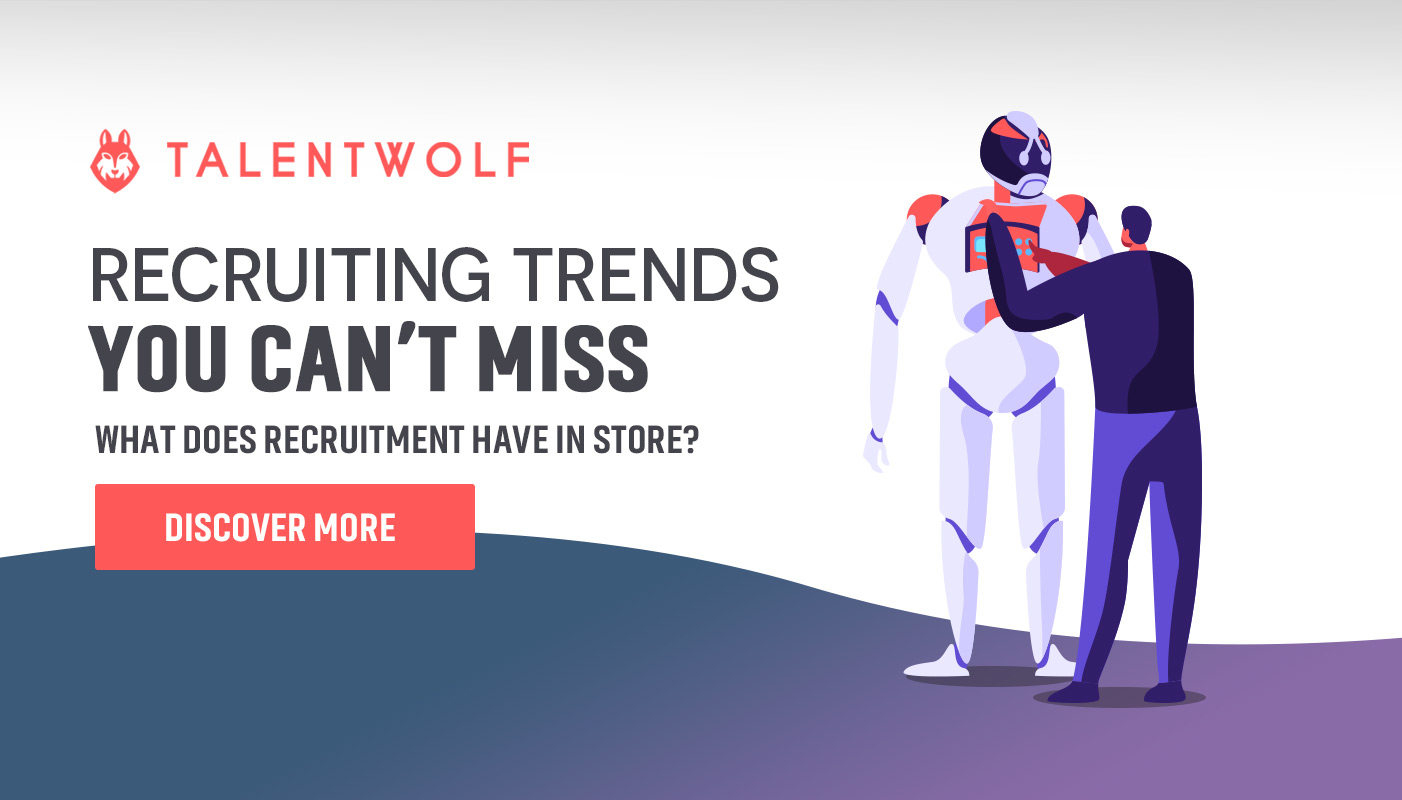One month ago, I was helping a recruiter with her social media marketing.
“What recruitment trends are bringing more value to you in 2020?” I asked her. “Which ones help you save time and win new business?”
“Hands down, it’s my online personal branding and the way I attract and retain the best candidates in the market,” she told me.
“The implementation of AI on our system also brought a big advantage in my daily activities” she added.
“Okay, let’s take a look at what you’re doing there,” I said.
We started checking out her social media profile and activity. She showed me some of the things she had done that brought in a lot of leads and engagement.
What I discovered really surprised me.
I’ve known that being very active online and updated with the latest trends would give you a competitive advantage.
But this recruiter wasn’t only focusing on LinkedIn and Job boards like many other recruiters would do.
Instead, she was driving candidate, clients and online engagement and retention through some new interesting technics.
After some research I decided to write down a list of the latest trends in the recruiting market, hoping it could give the competitive edge to many other recruiters keen to look for the latest updates.
Here a list of recruiting trends
1. Prioritising candidate experience
Did you know that candidates who are satisfied with their recruitment process are 38% more likely to take the job? What’s more, even if they’re not successful but the candidate experience was positive, they will most likely recommend your hiring organisation to others (source of statistics: IBM Smarter Workforce Institute “The far-reaching impact of candidate experience”).
Positive recruitment experience can make or break your brand, so how do we deliver a 5-star hiring experience?
- Treat your applicants as clients - work on the quality of your customer service
- Hiring journey should convince the applicant to become an employee of the organisation you’re hiring for. Make them feel like a valuable asset, provide feedback and advice.
- Segment candidates and choose your approach based on different talent segments. A person applying for a part-time job will have different goals and expectations than a freelance candidate. Customise your message and map out job seeker journey for each sector.
2. Hiring for soft skills
By 2030 we will experience 29 million skills shortage and a lion’s share of this number is going to be soft skills (Source: Deloitte: The path of prosperity: Why the future of work is human”). More and more jobs are relying on outstanding communication skills, therefore candidates who possess them will be of great value to all organisations. How do we define soft skills? It’s the ability to collaborate, communicate and empathize with others.
“Skills of the heart” will be given more value in the next decade, in some cases even more than the actual working experience, as being an agile communicator allows the workers to easily upskill and move into new roles. Hiring candidates for the ability to collaborate is, in fact, hiring them for the ability to adapt to changing reality. The future belongs to innate soft skills owners, as those are the least susceptible to automation.
Read more about the importance of soft skills at work:
- Soft Skills Hard Results: A Practical Guide to People Skills for Analytical Leaders
- Great on the Job: What to Say, How to Say It. The Secrets of Getting Ahead.
3. Attracting the best candidates by creating a compelling employer brand
As a recruitment professional you need to know what makes a great employer brand and how to “sell” a job position to your candidates. Job seekers are attracted by the unique culture, values and ethics of the company. Even better if you can demonstrate that the employer you’re hiring for has a positive impact on the world!
The career site and social media are also big factors in achieving authenticity and brand resonance. Sometimes the biggest obstacle that the candidates experience is not knowing how it’s like to work for a certain employer. Address those concerns by sharing more details with your applicants.
Read more about employer brand:
- The Employer Brand: Bringing the Best of Brand Management to People at Work
- Employer Brand Management: Practical Lessons from the World's Leading Employers
4. Automation of Recruiting
Integrating automation into hiring process will cut costs, provide you with effective marketing tools and applicant tracking software.
HR automation tools are increasingly used by recruiters in their tasks. These integrated technology solutions help to find, attract, engage, nurture, and convert candidates to become applicants. By automating the hiring process, these tools help streamline recruitment, making it more efficient and faster.
Source: LionessMagazine / Recruiterbox
The following applicant tracking software brands are worth giving a shot:
Check them out to remain competitive amongst other businesses who have already automated their recruitment practice and move your candidates through the best hiring process in the market!
Read more about the automation of recruiting:
- Musings of Man and Machine: How Robots and Automation Will Change Recruiting
- Tech Recruitment Automation A Complete Guide - 2019 Edition
5. Talent Pools
67% of large companies have difficulty filling roles, as well as 56% of medium-sized business globally.
Turning to your own talent pools might be the secret recruitment strategy of 2020. Grow your talent pools consistently and it will quickly pay off.
Reduce the cost of recruitment by up to 50% by updating your talent pool correctly and eliminating the need to advertise.
Reduce the time to hire: When using talent pools you can reduce time, as the work of screening, selecting and prequalifying candidates is done for you. Talent pools allow you to move quickly to fill the role with the right candidate with minimal impact
Identify quality candidates for the future: Having a strong talent pool can help you identify potential external candidates before the role needs to be filled.
Use an “Expressions of Interest” form: it's a quick and simple way for both passive and active jobseekers to express their interest in working for your organisation.
Implement Social media and Google Ads campaigns to increase brand awareness.
6. AI for Recruiting
AI can support the hiring process by removing some manual tasks, improving the candidate experience and saving your valuable time. The most promising automation are chatbots designed for applicant pre-screening, new hire monitoring and employee onboarding programs. Without any doubt, many parts of the recruitment process are going to be soon streamlined or automated especially if they’re repetitive and high-volume tasks. Use AI as a secret weapon to automate your workflow and become more time-efficient.
A recent survey found that 50% of firms use AI to source and screen candidates, in addition to using it to schedule them for interviews.
Benefits of using AI for recruiters
Manually screening resumes is still the most tedious part of recruiting, especially when 75% to 88% of the resumes received for a role are unqualified. Screening resumes and shortlisting candidates to interview is estimated to take 23 hours of a recruiter’s time for a single hire.
- AI for recruiting it's an enormous help for recruiters if it can successfully automate time-consuming, redundant assignments, for example, screening resumes or planning interviews with candidates.
- Early adopter organizations utilizing AI-powered recruiting software have seen their cost per screen diminished by 75%, their revenue per employee improve by 4%, and their turnover decline by 35%.
Challenges of using AI for recruiters
- AI that uses machine learning needs a lot of data to learn how to screen resumes as accurately as a human recruiter. This can mean several hundred to several thousands of resumes for a specific role.
- Make sure the AI software vendor you use is aware of these issues and has taken steps to remove clear patterns of potential bias
- Naturally, recruiting leaders can be sceptical of any innovation that promises to make their jobs easier. They want to be sure that any software that will automate one of their work assignment is going to be able to do as great of a job as they can.
AI is finding its way into every part of the recruitment process, from sourcing through pre-selection and interviewing to reference and background checks and determining fair compensation.
Here are some of the most innovative uses of AI in recruitment we’ll be seeing more of in 2020.
- Metaview listens in to job interviews and pulls out insights so that organizations can interview more effectively and make better hiring decisions.
- Checkr is an example of a background check company that uses artificial intelligence and machine learning.
- Jointl and Robin are an examples of companies in the automated reference check space
Read more about Artificial Intelligence in recruitment:
7. Social Recruiting
Use social networks to find talent. If you’ve never considered social media to be an effective hiring channel, it’s time to change your approach. One-on-One engagement with candidates it the key to creating a unique relationship with job seekers and make them feel cared for. 84% of businesses are already using social networks to find new employees. What can you do to stay in the game? Don’t limit yourself just to posting the vacancy, but also actively research promising candidates and engage with them personally using social media.
8. Grow your online brand
Candidates rely heavily on social media, before choosing the hiring company or employer. Be transparent to your applicants and share with them your profile on Talentwolf, where they can read through reviews, understand what are your specialisations as well as achievements, and in consequence gain trust towards your recruitment services.
9. Candidate Relationship Management
It’s a modern strategy for solving problems with talent acquisition. Recruiters report that most of the present candidate acquisition trends are driven by the job seeker. We want to change that trend by improving relationship with current and future candidates.
The key to building a strong relationship with job seekers is treating them as customers, creating engaging email campaigns and providing interesting content. Over 75% of professionals are passive candidates, they’re therefore a talent, that waits to be attracted by your brand.
10. Proactive hiring methods
Streamline and accelerate your hiring workflow by creating a strategic approach and managing your talent pool better. Using marketing methods will help you attract and source candidates, who may in the future convert into applicants. Keep in mind that you need to continuously receive high-quality applications, regardless if there are any open positions at the moment or not.
Proactive recruitment is focussed on sourcing, engaging and attracting candidates ahead of hiring demand.
Unlike reactive recruiting, proactive recruiting doesn’t depend on candidates applying for a position after it’s open. Instead, proactive recruitment focusses on identifying talent before its demand, establishing contact, nurturing relationships and ultimately making the candidate interested in an open opportunity.
The proactive methodology covers the entire five phases (Source, Engage, Nurture, Attract and Convert) which turns strangers into employees and promoters of the company.

A proactive recruitment strategy is when you actively seek candidates that may be suitable for roles within your company even when there are no roles to fill. You plan ahead for the eventuality that someone at some stage will inevitably leave the company or that the company may decide to create new departments or expand existing ones.
It’s not enough to simply add a candidate to your pipeline and leave them there until a role becomes available. You’ll need to nurture that relationship and keep those leads warm.
Occasional calls or messages will certainly help maintain their interest while you can also add them to a company newsletter subscriber list by taking a proactive approach and planning for all eventualities you can accelerate your time to hire, reduce your cost per hire, and potentially attract higher-quality candidates.
11. Emails – recruitment marketing staple
2020 will bring numerous innovative strategies to the hiring industry, however, email marketing is still holding a strong position in establishing regular communication with candidates and reaching out to a broad audience. The true power lies in combining emails with AI automation to achieve greater personalization and adjusted content for every candidate.
Combined with the right CRM platform, email marketing permits you not exclusive to communicate focussed messages but to keep your finger on the pulse of your talent pool. As a related side note – while email marketing is extremely easy to execute, it shouldn’t be abused. Sending out too many promotional emails will quickly turn off your email recipients and encourage them to unsubscribe. Make sure your emails are truly substantial and filled with rich content that applies to your targeted audience.
Discover here some of the major email marketing software available in the market
It's best to choose the right technology. Not all platforms offer the most appropriate features to meet your recruitment goals at a reasonable price. Some common email marketing features for recruitment and hiring include segmentation, personalization, landing page creator and so on.
Segment your list
Not all job seekers are actively looking for new opportunities. Basically, it’s not wise to email a job vacancy for a Digital Marketing Manager to an email list containing accountants, engineers or sales managers.
By segmenting your contact list, you are sending targeted emails, which means delivering appropriate job openings that match the job seekers professional background and skill set.
You can perform segmentation in different ways:
Create separate lists for active and passive job seekers based on their online behaviour and email engagement. Further segment your list based on industry, years of experience and skills. Your segmentation options are limitless.
Personalize
Across industries, personalized emails have 29% higher unique open rate and 41% unique click rates than non-personalized emails.
Do this by sending job seekers with a series of job postings relevant to their professional background, skill set, and industry. For non-active job seekers, you could send them blog posts about career development, job interview tips.
Read more about email marketing automation:
12. Employee stories
What’s the best way to improve the perception of your brand? Employee stories are a perfect tool for sharing the brand’s vision and values with the potential candidates. The stories are told through videos or blogs all of which allows the audience to connect emotionally with the brand.
“Behind the scenes” videos and articles are the keys to creating a long-lasting relationship with job seekers. The authenticity of employee stories will be, without a doubt, a growing trend in the years to come.
Hiring process gets more and more challenging every year, so we don’t expect it to get any easier in 2020. But don’t worry – by staying on top of the industry trends you can surpass your competition and create a unique candidate experience.
Attracting talents is a subtle game requiring regular use of marketing and social tools, but as your talent pool grows the time to hire goes down and your efficiency improves. Make this year a better one with the top 12 recruiting trends.





